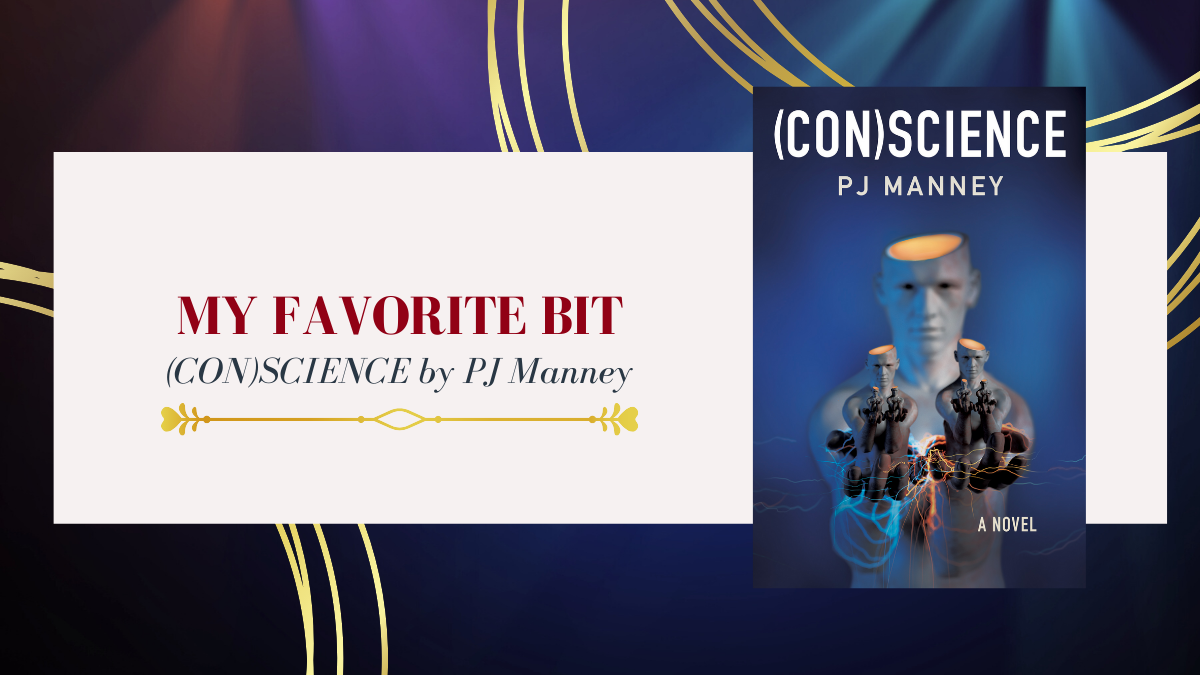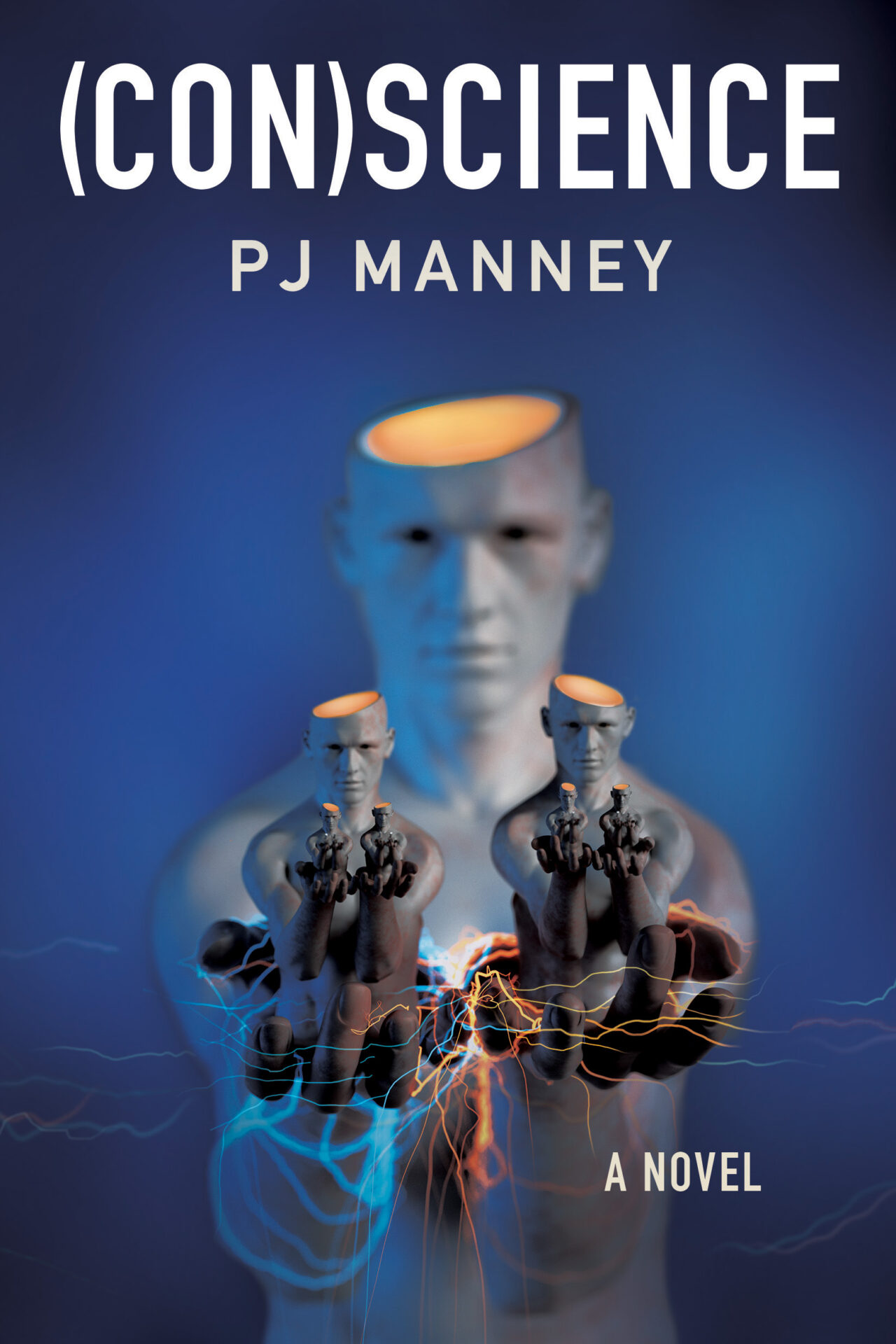
PJ Manney is joining us today to talk about her novel, (CON)science. Here’s the publisher’s description:
PJ Manney concludes her visionary Philip K. Dick Award–nominated series of a world at war, a virtual search for identity, and the future of humanity.
Five years ago, bioengineer Peter Bernhardt spearheaded an innovation in nanotechnology that changed the course of evolution. Until everything was taken from him—his research, the people he loved, and finally his life. Uploaded as an artificial intelligence, Peter is alive again thanks to a critical reactivation by fellow AI Carter Potsdam.
But a third sentient computer program, Major Tom, is tearing the United States apart, destroying its leaders and its cities. Major Tom’s mission: rebuild a new America from the ruins and reign as uncontested monarch. Carter knows that only a revolutionary like Peter can reverse the damage to a country set on fire.
Caught in a virtual world between an alleged ally and an enemy, pieces of Peter’s former self remain: the need for vengeance, empathy for the subjugated people of a derelict world, and doubt in everything he’s been led to believe. To rescue what’s left, he’ll need to once again advance the notion of evolution and to expand the meaning of being human—by saving humanity.
What’s PJ Manney’s favorite bit?

PJ MANNEY
We’re not supposed to have favorite children. But I admit to having a favorite character in (CON)SCIENCE and the entire Phoenix Horizon trilogy: Dr. Ruth Chaikin, the brilliant neuroengineer who helps Peter Bernhardt build a brain computer interface, uploads him as the first artificial human intelligence (AHI), and oversees the creation of AHIs that change the world. For all her neurodiversity and pointedly honest repartee, I love her spoken Yiddish most of all. She may stutter in her staccato English, but she is smooth and funny in her idiomatic Yiddish speech, which luckily Peter Bernhardt, Major Tom and Tom Paine can translate on the fly as artificial intelligences, even if they struggle with her true intent.
I didn’t grow up speaking Yiddish. Like many Jewish families who arrived in America in the first half of the 20th Century, mine desired to assimilate. My maternal great grandmother, Hilda, arrived in New York speaking seven languages: Hebrew, Yiddish, Polish, German, Russian, French and English. Beyond some high school French, I only speak English, and what we call “Seinfeld Yiddish,” meaning the bits you pick up raised in a New York Jewish family, while surrounded by people of every ethnicity who understand how to insult a schmuck as he schleps his khazeray and cuts off the schlimazel from boarding the Midtown bus, while boring the driver with his shpiel. Even if you don’t precisely understand the words I wrote, Yiddish is so onomatopoetic and pervasive in American film and television, you can gather the meaning.
My maternal grandmother, Florence, spoke Yiddish to my parents when she didn’t want me to understand their grown-up discussions about money, sex or scandal, especially any story involving all three. My father could answer in Yiddish, but my mother could only discern the gist and mutter monosyllabic English back.
As I researched appropriate dialogue for Ruth, I recognized phrases I’d heard my grandmother say decades before in these discrete conversations. Surprised, I called my mother.
“Wow, Mom. Grandma had a real potty mouth!”
Mom laughed. “You’re only just realizing that?”
Like my Grandma and Ruth, Yiddish is scatological, earthy, direct, honest. No feigning politeness, with metaphors that cut close to the bone. Yiddish trades darkness with humor. Like Ruth. So when Ruth says, Di grub iz shoyn ofen un der mentsh tut noch hofen, meaning, “The grave is already dug, and the man still continues to hope,” she is recognizing cockeyed optimism in the face of brutal reality. But with a half-smile and a wink.
Metaphorical meanings abound. The common explanation for schlemiel and schlimazel is, “A schlemiel carries a bowl of soup and trips. A schlimazel gets the spilled soup in his lap.” Everyone gets the flavor of the words, even if the etymological derivations have nothing to do with tripping or soup.
And really, what language has so many onomatopoetic words for male genitalia as an insult? Schmuck/shmock, schmeckel, shvantz, shtupper, schlong, strunckel/shtrungool, putz, petzl, petseleh, shtick, eyver or (menlekhe) eyvrim, mileh/mile.
I relied on the Internet for Ruth’s phraseology and spellings in the trilogy’s first two books, (R)EVOLUTION and (ID)ENTITY. Because Yiddish is not a written language in Romanized letters, but in Hebrew letters, different Jewish nationalities have their own preferences how to transliterate Yiddish. As a creole of Hebrew and Eastern European languages, my Yiddish was a combination of dialects. My grandparents spoke Russian, German and Polish, as well as New York English, so who knows what versions I subconsciously adopted. Russian Jews transliterate Yiddish differently from German Jews and again from Hungarian Jews. But they’d all spell it the same in Hebrew.
It wasn’t until (CON)SCIENCE that my publisher had a Yiddish proofreader standardize all the Yiddish spelling into the YIVO (Yidisher Visnshaftlekher Intitut or Yiddish Scientific Institute/Institute for Jewish Research) standard. Check out the multiple spellings for “thief.” I spelled it gonif. The professional YIVO translators spell it ganev. And there are so many more spellings, depending on your accent: gannif, ganif, gonnif, gonef, ganef, ganav, ganov.
YIVO uses the Litvish accent as standard, meaning the accent common to people from the Lithuanian cultural area. Ruth’s father, Russian scientist Dr. Nikolai Chaikin, was born in Minsk, worked in Moscow and was a political émigré to the US with his wife and only child, Ruth. So Litvish would have been the Yiddish dialect the Chaikins used at home. So Danken Got, that worked out well.
Surprisingly, I have never received a letter from a Yiddish speaker complaining about inconsistent transliterations before. As they say, “Two Jews, three opinions.” Thank you, Yiddish readers. That would have been a rabbit hole from which I might never have emerged.
Yiddish permeates my life, even if I don’t speak it. I’m often asked if I’m a plotter or a pantser. I’m a plotzer, which sounds like something in between. However in Yiddish, plotz is a verb meaning to crack, collapse or explode, and a noun meaning place, so you get extra points by grasping my writing process if you understand Yiddish. I structure and flow, I explode and collapse, but somehow keep my tuchus seated in one place. It’s contradictory, paradoxical and yet understood. Like writing. And Yiddish. Because you can’t say “truth” without “ruth.”
LINKS:
(CON)science Universal Book Link
BIO:
PJ Manney is the author of the Phoenix Horizon trilogy: (CON)science, (ID)entity, and the Philip K. Dick Award nominee (R)evolution. A devotedly positive futurist, she was chairperson of the board of directors of Humanity+, an international nonprofit organization that advocates the ethical use of technology to expand human capabilities. Manney has also been active in communications, public relations, and film production. To date, she has written numerous scripts for television pilots and has also worked on shows such as Hercules: The Legendary Journeys and Xena: Warrior Princess. She has lived as far afield as New York and New Zealand and loves delving into the cultural landscape of wherever she finds herself. When she’s not writing, she continues to expound on her perspective of a technology-driven posthumanity while encouraging hopeful visions of the future. She lives with her husband of thirty-one years and their two children. For more information, visit www.pjmanney.com.
